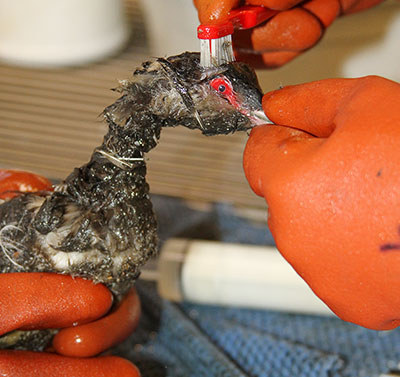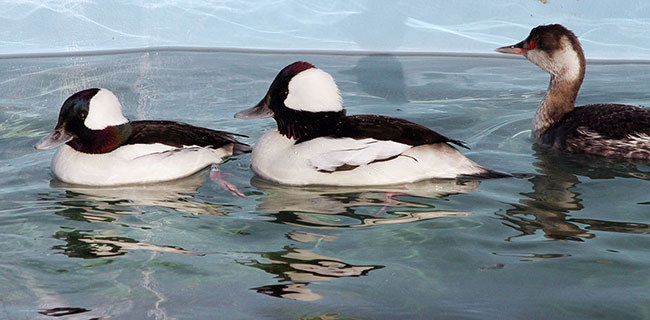#MysteryGoo 102 birds have died while being treated. 197 remain at center.
Dozens of birds rescued and cleaned of a mysterious goo earlier this month were released back into San Francisco Bay on Wednesday as planned. It was the first of several planned releases that are scheduled to take place in the coming week.
Officials have yet to identify what the sticky substance was or where it came from. More than 200 seabirds succumbed to hypothermia and died as a result of the contamination.
Still, rescuers were able to save more than 240 of the birds, cleaning their feathers and bringing their body temperatures back to normal levels.
Judging from the photos, the birds were more than ready to get back out on the bay.
#MysteryGoo birds lined up to be release back into the SF Bay! @DawnDish @IntBirdRescue #DawnDayintheWildlife
#MysteryGoo First 24 Mystery Goo Seabirds released back to freedom this morning in Sausalito. Goo remains unknown.
Rescuers plan to release the first batch of recovered birds Wednesday morning near Golden Gate Bridge in Sausalito — a food-rich area. While the source of the mystery goo has yet to be determined, no new affected birds have been brought to the International Bird Rescue center since Thursday and rescuers are confident that the danger has passed.
More than 240 birds have already been washed and are recuperating in dozens of pools at at the San Francisco Bay center in Fairfield. Rescuers plan to release the birds in batches over the coming week.
The California Department of Fish and Wildlife, meanwhile, continues to test samples of the sticky substance to determine what it is and where it came from.
With no federal or state aid in the picture, the rescue center again appealed on Facebook for public donations to help defray the cost of the operation.
The mystery over that gooey substance that has killed hundreds of birds in and around San Francisco Bay deepened this week after the No. 1 suspect was ruled out by scientists.
At least 280 seabirds have already died since since they were discovered late last week along the eastern shoreline covered in a mysterious goo that continues to baffle experts.
Even though the sticky substance is not considered toxic, it has proven deadly as it separates the birds' feathers, letting in cold air and water. For the unlucky, it can lead to hypothermia and death.
California wildlife officials had suspected that the substance was polyisobutylene — a synthetic rubber and fuel additive responsible for killing thousands of seabirds in U.K. in 2013 — but recent lab tests shot down that theory.
Andrew Hughan, a spokesman for the California Department of Fish and Wildlife, told the San Francisco Chronicle that "there are still lots of other things it could be."
"This is a full-bore effort," he said. "The lab has got its whole staff going. They are testing for everything."

Meanwhile, the rescue effort continues to operate at full steam as more goo-covered birds are discovered.
During triage, volunteers have been using syringes to force feed the birds warm water to help them raise their body temperatures from the inside out. Once they're stabilized, volunteers use a washing solution that includes soap, vinegar and baking soda to clean the feathers.
"The good news is that we have modified our wash protocol and it appears to be
working on healthier birds," Barbara Callahan, interim executive director of the International Bird Rescue, said in a statement.
However, she added, some of the birds are in much poorer condition, likely because they've had the substance on their feathers for several days.
The International Bird Rescue has been taking the lead on coordinating the response from its center in Fairfield.
The nonprofit released an update Wednesday on the number of injured birds:
Found Dead: At least 280
Transported to rescue center: 321
Live in care: 271
Washed: 135
The seabirds — which include Surf Scoters, Horned Grebes, Buffleheads, Scaups, and smaller shorebirds — have been collected along the East Bay shoreline, including areas in Alameda, especially around Bay Farm Island Shoreline Park south to San Leandro Marina and around Hayward.
Great team effort by @IntBirdRescue @ebrpd Wildlife Emerg Svcs. Volunteers & staff. 300+ birds rescued. More tomorrow
Officials started testing the substance this week, but with polyisobutylene no longer a suspect, the wait continues.
CDFW continuing investigation of mystery substance in #SFBay Labs working full time on it. Info here when available. No timeline for results
As the rescue continues, so do the costs.

Because no culprit for the substance has been identified, the International Bird Rescue is appealing to the public for donations to help cover the costs of the rescue operation.
Callahan estimated that it costs $8,000 a day to pay for the care and washing of the seabirds, "and we so appreciate the public's support of these beautiful birds."
To donate, go here.
